Heat pumps that use natural energy to extract heat in heating and water supply systems are gaining popularity. The choice of such systems on the market is great, however, the price is also high. The editors of the site "bestx.htgetrid.com/en/" have prepared for you an overview of the best heat pumps for 2020.

Content
Principle and diagram of the heat pump, types
Principle
The design of any heat pump includes 2 parts: external (absorbs heat from external sources) and internal (transfers the removed heat directly to the room heating system). External renewable sources of thermal energy are, for example, heat from the earth, air or groundwater. This design allows you to significantly reduce the cost of heating or cooling for a private house, because approximately 75% of the energy is generated thanks to free sources.
Scheme of work
The heating system includes: evaporator; capacitor; a discharge valve that reduces the pressure in the system; compressor that increases pressure. Each of these units is connected to each other by a closed circuit of a pipeline, inside which there is a refrigerant. The refrigerant is in the liquid state in the first cycles, in the next - in the gaseous state. This substance has a low boiling point, therefore, with the option of an earth-type equipment, it can be converted into gas, reaching the level of the ground temperature. The gas then enters the compressor, where strong compression occurs, which leads to rapid heating. After that, hot steam enters the inner part of the heat pump, and is already here used directly for heating rooms or for heating water. The refrigerant then cools, condenses and becomes liquid again. Through the expansion valve, the liquid flows into the underground part to repeat the heating cycle.
The principle of cooling such an installation is similar to the principle of heating, but not radiators, but fan coils are used. In this case, the compressor does not function. Cold air from the well enters the air conditioning system directly.
Types of heat pumps
What types of heat pumps are there? Distinguish between equipment by an external source of heat energy that is used in the system. Among the household options, there are 3 types.
Ground or earthen ("ground-air", "ground-water")
The use of an earth heat pump as a source of heat energy will ensure eco-friendliness and safety. The cost of such equipment is high, but its functionality is enormous. Frequent maintenance is not required and a long service life is ensured.
Ground source heat pumps can be of two types: with vertical or horizontal installation of pipelines.The vertical placement method is more expensive, as it requires deep well drilling in the range of 50-200 meters. With a horizontal arrangement, the pipes are laid to a depth of about one meter. In order to ensure the collection of the required amount of heat energy, the total area of pipelines should exceed 1.5-2 times the area of heated premises.
Water pump ("water-air", "water-water")
For southern regions with a warm climate, water installations are suitable. In water bodies heated by the sun, the water temperature at a certain depth is relatively stable. It is preferable to lay the hoses in the very bottom of the bottom, where the temperature is higher. A load is used to secure the underwater pipelines.
Air ("air-water", air-air ")
In an air-type installation, the source of energy is air from the external environment, which enters the evaporator heat exchanger, where the liquid refrigerant is located. The temperature of the refrigerant is always lower than the temperature of the air entering the system, so the substance immediately boils and becomes a hot vapor.
In addition to classic models, combined installation options are in demand. Such heat pumps are supplemented with a gas or electric heater. In poor climatic conditions, the performance of the heating device decreases, and the device switches to an alternative heating option. Such an addition is especially relevant for equipment of the "air-water" or "air-air" type, since it is these types of equipment that are characterized by a decrease in efficiency.
For regions with long, cold winters, it is safer to use a ground source heat pump. Air heat pumps are suitable for areas with a mild southern climate. Also, when installing equipment that uses the energy of the earth, the characteristics of the soil should be taken into account. The productivity of the heat pump will be much higher in clay soil than in sandy one. In addition, the depth of the location of the pipelines is important, the pipes must be laid deeper than the level of freezing of the earth in cold periods.
The best heat pump manufacturers
Feedback from buyers allowed us to compile a rating of quality heat pump manufacturers using the best components for the production of heating equipment. These companies include:
- The international company Stiebel Eltron, founded in Germany in 1924.
- American company Cooper & Hunter.
- Japanese brand Daikin.
- Mitsubishi Corporation (Japan).
- The youngest manufacturer on the market is Kitano.
- Gree Electric (China).
- Hitachi supplies versatile equipment to fit any building.
- Panasonic (Japan).
The indisputable leaders in the production of high-quality heating equipment today are Japanese companies.
It is better to decide which company to purchase the installation, after considering all the characteristics and conditions in which it will be operated.
The most popular heat pump models
To understand how to choose equipment to get real savings, how much it costs, and what the payback period will be, you need to get acquainted with its main types.
TOP models according to buyers are as follows:
Geothermal
Another name for these devices is the "ground-water" system. It takes heat from the soil below the freezing point, where even in winter a slightly positive temperature remains. For work, it requires the construction of wells up to 100 meters deep or horizontal laying of a system of heat exchanger pipes in the ground. This limits the possibility of self-assembly of such equipment. The average price, taking into account the underground pipeline, is higher than that of air-type pumps.
Ground source heat pump Stiebel Eltron WPC 10
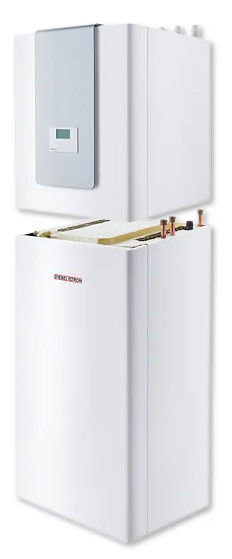
Products with German quality from a well-known industry leader are compact. Convenient control (touch display). The approximate price is 580 thousand rubles.
- Power 10kW;
- The required well depth for installation is 200-250 m.
Advantages:
- Compact dimensions;
Disadvantages:
- Dear;
- Low heating power compared to colleagues.
Daikin ground source heat pump EGSQH10S18A9W
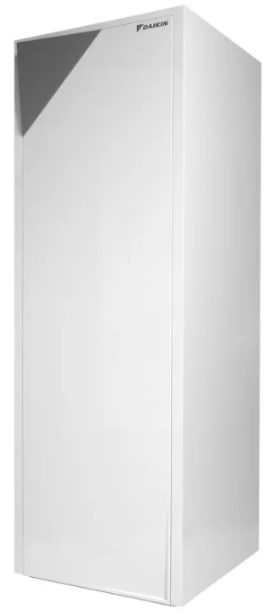
Heated capacity up to 130 sq. m., built-in hot water tank, electronic control saves energy. Average cost of 1.5 million rubles.
- Thermal power 13 kW;
- Power consumption 2.34 kW;
- Operating temperature range from 5 to 60 ℃.
Advantages:
- The parameters of equipment with heat extraction from the ground are 20-25% more efficient than air ones and practically do not depend on changes in street temperatures.
Disadvantages:
- High price.
Ground source heat pump Stiebel Eltron WPC 13
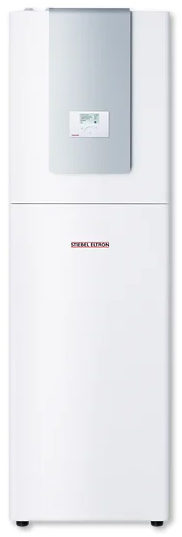
The model is characterized by its compact size and high power output. The approximate cost of the device: 600 - 630 thousand rubles.
- Thermal power 13 kW;
- The optimum well depth is 260 - 325 m.
Advantages:
- Compact dimensions;
- High level of heat energy produced.
Disadvantages:
- Complexity of installation;
- The need to drill deep wells.
For hot water heating
For the installation of heating systems, installations are of interest, the installation of which can be carried out at home without carrying out large-scale earthworks to take heat from the ground. Therefore, the most widespread are heat pumps of the "air-water" system.
FAIRLAND AHP13AS
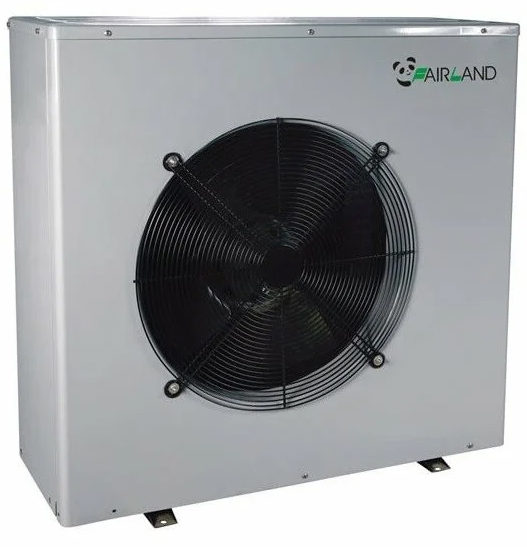
Used for heating, hot water supply and pool water heating. It is possible to use hybrid heating for radiators and in underfloor heating systems. Low noise level. Assembled from original Japanese components.
- Heating power - 13 kW;
- The maximum noise level is 55 dB;
- Power consumption 2.9 kW.
Advantages:
- Low cost (about 200 thousand rubles);
- Possibility of use for swimming pools.
Disadvantages:
- There are no air cooling functions;
- Operates only from 380 V.
FAIRLAND AHP10A
Designed for heating swimming pools, this unit is also good as a heat source in the hot water heating circuit.
- Heating power - 10 kW;
- The maximum noise level is 55 dB;
- Power consumption 2.3 kW.
Advantages:
- Its characteristics make it possible to receive up to 10 kW of thermal energy from 2.3 kW of power consumption.
Disadvantages:
- Produced in China from Japanese components, so the quality is sometimes unpredictable;
- Designed to operate at an air temperature of at least -15 ° C, which is not always feasible in the climate of the Russian Federation.
Cooper & Hunter CH-HP3,5SWNK
Equipped with split compressor and heat exchanger. It has a low noise level, so installation for servicing residential premises is possible. Ideal for underfloor heating. It has an external tank with a built-in heating element for 1.5 kW as additional insurance in case of sharp drops in air temperature. It is possible to order online with instructions on how to install the device yourself.
- Heating power - 3.5 kW;
- Maximum noise level - 63 dB;
- Power consumption 0.85 kW.
Advantages:
- Low cost in the range of 185 - 200 thousand rubles.
Disadvantages:
- Relatively low power;
- The limited size of the heated area, the time for heating the water to +55 ° C is more than 4 hours.
Inverter
This is the name of the units with the possibility of smooth regulation of the compressor power. They are characterized by more accurate temperature control, due to the absence of transient starting processes, equipment wear is reduced. Since there is no abrupt switching mode, inrush currents do not occur in the power network (which may be important for weak wiring far from settlements).
The compressor is controlled according to the frequency principle: the alternating current of standard parameters is converted by the rectifier into direct current. Then the electronic device again converts it into an alternating voltage, but this time a high frequency. Such a solution becomes a particular advantage if an intelligent heating system is designed that reacts to external factors without the participation of a human operator.
Rating of the best devices of this type in 2020:
- FAIRLAND AHP13AS;
- Cooper & Hunter CH-HP3.5SWNK;
- FAIRLAND AHP10A.
The description of these models has already been given above.
For swimming pool with built-in boiler
The use of aggregates that collect heat from the environment allows saving up to 80% of energy, and the presence of a built-in heat source in the structure gives the installation additional reliability. Their feature: increased requirements for anti-corrosion protection of parts, since the water in the pools is usually saturated with chemically active substances (chlorine, ozone).
Ground source heat pump Danfoss DHP-S 26 Eco
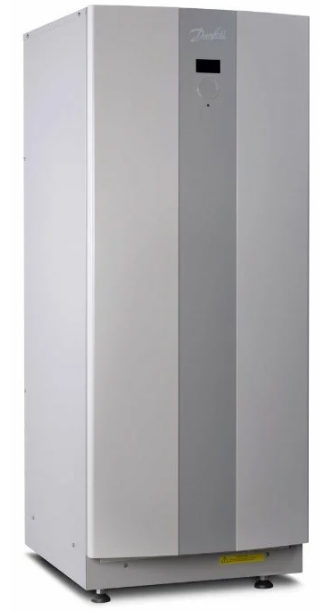
A modern heat generator with high reliability, powered by a geothermal probe installed in wells with a total depth of 500-650 m. The cost of the model is 1.1-1.2 million rubles.
Advantages:
- The HGW function allows heating and hot water heating at the same time.
Disadvantages:
- Impossibility of self-assembly by the user.
Danfoss DHP-L Opti Pro + 17
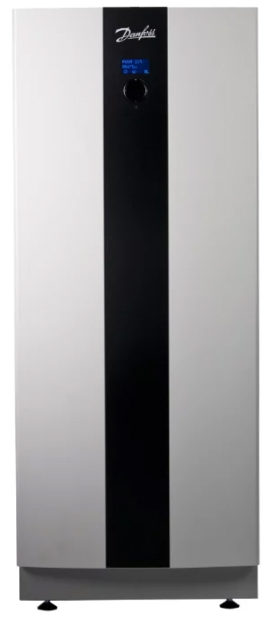
Another solution from the market-leading Swedish brand. Has a thermal power of 17 kW, requires wells with a total depth of 300-400 m. The approximate cost is 900 thousand rubles.
Advantages:
- Weather dependent control;
- variable speed circulating pumps and HGW technology allow an average annual efficiency increase of up to 20% compared to other modifications.
Disadvantages:
- High price.
Danfoss DHP-S 33 Eco
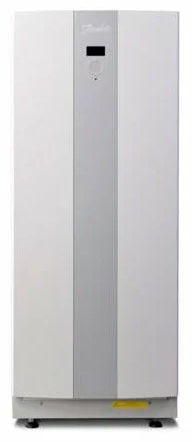
The installation with a thermal power of 33.5 kW, the total depth of the wells for the heat carrier is 650-830 m. The price range for the installation ranges from 1.2 to 1.3 million rubles.
Advantages:
- High power level.
Disadvantages:
- Complexity of installation.
All models shown are equipped with an external water tank and an electric heater. They can also be networked with any other thermal equipment (solar, gas, liquid, solid fuel energy sources).
The recommendations and advice of specialists when choosing a heating system boil down to the fact that for regions with a temperate or polar climate it is better to give preference to geothermal heat pumps, because a ground installation at low temperatures will work without a decrease or loss of performance. However, most people purchase air-to-water heating systems. The popularity of these models is explained by the fact that these are low-cost options for heat pumps and are quite simple to install (upon purchase, an accompanying material is issued - step-by-step installation instructions), in contrast to geothermal systems, the installation of which is better planned during the construction of a building. At a price the most inexpensive options for earth heat pumps significantly exceed the cost of equipment of the "air-to-water" and "air-to-air" class. To eliminate mistakes when choosing a heating system, it is necessary to consult with a specialist and take into account all the conditions of the premises that the heating equipment will serve. And only after that, decide which pump is better to buy.
Advantages and disadvantages of heat pumps
Heat pumps are easy to use and virtually silent. Safe and reliable, a house with such a system has a high level of fire safety. When operating your own heating and air conditioning system, heating costs are significantly lower than when using other systems. Many models provide not only a heating function, but also a cooling function.
The main disadvantage of using such a system is the high cost of equipment and, in some cases, installation. The amount invested in the installation of a heating system can fight back for years. In some cases, it is cheaper to use alternative energy sources. Another drawback, in old modifications of heat pumps, is insufficient heating of water, only up to the level of 60 ℃. But new items on the market today do not have this flaw.
Where to buy the equipment you like, you will have to choose yourself. Some models can be ordered both in retail chains and in the online store.Today there are many resources on which you can find a detailed description of the model, the average price level, as well as useful feedback from the owners.
If you have experience in using the heat pumps described in the rating, or you want to share information about another model, tell us about it in the comments.












